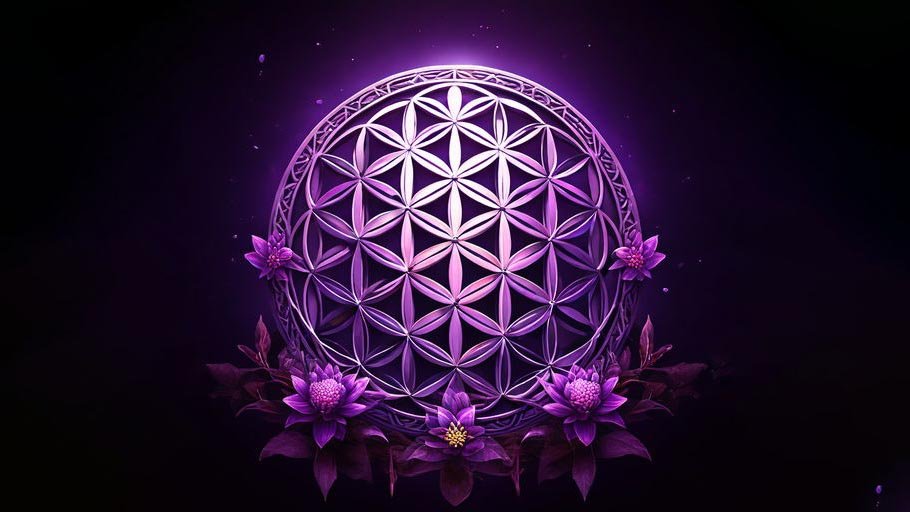The Flower of Life: Unlocking Its Hidden Meaning
Have you ever come across an intricate geometric pattern that seems to hold deep symbolism and captivates your imagination? The Flower of Life is one such symbol that has fascinated humanity across cultures and generations. From ancient mythologies to modern spirituality, this intricate design carries profound meanings and represents the essence of creation. In this article, we will explore the rich symbolism and mythology behind the Flower of Life, delve into its sacred geometry, uncover its spiritual significance, and discover practical ways to incorporate its power into our daily lives.
Key Takeaways:
- The Flower of Life is an intricate geometric pattern that holds deep symbolism.
- It represents the essence of creation and is found in various mythologies.
- The symbol has profound spiritual significance and practical applications for personal growth.
The Sacred Symbol in Ancient Civilizations
Throughout history, the Flower of Life has been revered as a sacred symbol in different civilizations. Its presence can be traced back to ancient times, where it held great significance in various mythologies and cultures.
Egyptian Mythology: Symbol of Divine Creation
In Egyptian mythology, the Flower of Life was associated with the creation story of the universe. It symbolized the birth of the cosmos and was believed to be a representation of the blueprint on which all life forms were created. The symbol adorned sacred temples and tombs, emphasizing its divine origins.
Hinduism: Representation of Cosmic Energy
In Hinduism, the Flower of Life is intricately linked to the concept of cosmic energy and the interconnectedness of all living beings. It is considered a visual representation of the Divine, representing the manifestation of consciousness unfolding from one source. The symbol can be found in temples, artwork, and spiritual texts, signifying the eternal cycle of creation and renewal.
Sumerian and Mesopotamian Culture: Connection to the Tree of Life
The Sumerians and Mesopotamians also recognized the significance of the Flower of Life, often connecting it to the concept of the Tree of Life. This tree symbolized the interconnectedness of all things in the universe. The Flower of Life, with its intricate interlocking circles, represented the unity and harmony of all existence.
Chinese Philosophy: Balance and Harmony
Chinese philosophy embraced the Flower of Life as a symbol of balance and harmony. The pattern was perceived as a reflection of the natural order of the universe. It conveyed the Daoist concept of the interplay between Yin and Yang, symbolizing the complementary forces of duality that make up the whole.
Ancient Greek Mysteries: Symbolism of Life and Death
In the ancient Greek mysteries, the Flower of Life was associated with the cycles of life and death. It represented the continuous process of birth and rebirth, symbolizing the eternal nature of the soul. The symbol was intricately woven into ancient Greek art, revealing its importance within their cultural and religious practices.
The Intricate Design and Symmetry
The Flower of Life is characterized by its intricate design and remarkable symmetry. It is composed of circles arranged in a hexagonal pattern, with each circle intersecting with six others. This geometric arrangement creates a mesmerizing and harmonious pattern that captures the eye and sparks curiosity.
Geometry and the Universe
Geometry has long been regarded as the language of the universe, and the Flower of Life embodies this principle. Its symmetric and precise construction resonates with the underlying order found in nature, from the atomic structure to the cosmic scale. This geometric pattern has been observed in everything from seashells and flowers to planetary alignments, further emphasizing its connection to the broader fabric of existence.
Sacred Geometry: The Language of Creation
Sacred geometry explores the mathematical principles that underpin the creation of the universe. The Flower of Life is a fundamental symbol in sacred geometry, serving as a key that unlocks hidden knowledge and unveils the mysteries of existence. It encompasses other powerful symbols such as the Seed of Life, Metatron’s Cube, and the Tree of Life, making it a gateway to deeper metaphysical understanding.
The Seed of Life: Foundation of the Flower of Life
At the core of the Flower of Life lies the Seed of Life, a six-petal flower constructed from seven overlapping circles. This symbol represents the genesis of all life and contains the blueprint for creation. It is believed that within the Seed of Life, the building blocks of the universe can be found, including the geometrical and mathematical codes that govern reality.
Flowering Patterns: Expansion of Consciousness
As the Flower of Life unfolds, additional layers of circles emerge, creating a stunning “flowering” effect. Each layer expands upon the previous one, symbolizing the expansion of consciousness and the interconnectedness of all things. This multidimensional representation reflects the unlimited possibilities of existence and encourages individuals to explore the depths of their own consciousness.
Connection to Higher Consciousness
The Flower of Life is not merely a pretty pattern; it holds deep spiritual significance as a tool for connecting with higher consciousness and facilitating personal transformation.
Meditation and the Flower of Life Symbol
Meditation is an ancient practice that allows individuals to quiet the mind and explore their inner realms. When used in meditation, the Flower of Life symbol serves as a focal point, helping to channel attention and facilitate a deeper connection with one’s spiritual self. By gazing at the pattern while meditating, individuals can achieve a state of profound serenity, tapping into universal wisdom and gaining insight into their own purpose.
Spiritual Awakening and Self-Realization
The Flower of Life also serves as a catalyst for spiritual awakening and self-realization. Its intricacy and symbolism awaken dormant spiritual faculties, enabling individuals to transcend their limited perspectives and tap into their true potential. By meditating on the Flower of Life and contemplating its layers of meaning, individuals can embark on a journey of self-discovery and embrace their connection to the divine.
Uniting Body, Mind, and Spirit
The Flower of Life has the power to harmonize the trinity of body, mind, and spirit. As individuals recognize the unity of all things and align themselves with this cosmic order, they can experience a profound sense of wholeness and balance. This integration leads to increased vitality, mental clarity, and spiritual alignment, allowing for a more fulfilling and purposeful existence.
Healing and Transformation
The sacred geometry inherent in the Flower of Life carries an inherent energetic resonance that can promote healing on various levels. Its symmetrical design and geometric precision generate a powerful energy field that can cleanse and balance stagnant or disharmonious energies within individuals. By working with the Flower of Life symbol, individuals can facilitate profound healing and transformation, allowing for the release of old patterns and the integration of new levels of awareness.
Incorporating the Symbol into Daily Life
Beyond its spiritual significance, the Flower of Life also offers practical applications for those seeking to incorporate its power into their daily lives.
Jewelry and Accessories
Wearing jewelry adorned with the Flower of Life symbol allows individuals to carry its energy close to their hearts. Necklaces, bracelets, and rings featuring the intricate pattern not only serve as beautiful adornments but also act as personal talismans, reminding individuals of their connection to the divine and serving as an anchor during challenging times.
Home Decor and Sacred Spaces
Incorporating the Flower of Life into home decor and sacred spaces can create an ambiance of harmony and upliftment. Decorative items such as wall art, tapestries, and mandalas featuring the pattern can infuse living spaces with positive energy and symbolically enhance the flow of abundance, love, and creativity. Creating a dedicated altar or meditation space with the Flower of Life as the centerpiece further amplifies the space’s sacred vibration.
Tattoos and Body Art
For those seeking a more permanent reminder of the Flower of Life’s significance, tattoos and body art offer a creative and personal expression. The symbol can be intricately woven into unique designs, allowing individuals to carry its profound meaning on their skin. Tattoos serve as constant reminders of unity, transformation, and the eternal nature of existence.
Meditation and Visualization
Incorporating the Flower of Life into meditation and visualization practices can deepen the spiritual experience. By focusing on the symbol in one’s mind’s eye, individuals can tap into its energetic frequencies and access higher states of consciousness. Visualizing the Flower of Life expanding and radiating its harmonious energy can aid in relaxation, promote clarity, and enhance the effectiveness of affirmations or manifestation practices.
Conclusion
Embracing the Power of the Flower of Life
The Flower of Life is more than just an intricate geometric pattern; it holds within it profound meaning, spiritual significance, and transformative power. Across different mythologies, cultures, and spiritual practices, this symbol has captured the imagination and inspired generations. By understanding its rich symbolism, embracing its sacred geometry, and incorporating its essence into our daily lives, we can tap into the universal truths it represents and embark on a journey of self-discovery and spiritual awakening. The Flower of Life invites us to explore the depths of our consciousness, unlock our creative potential, and reconnect with the divine source of all existence.
Frequently Asked Questions
1. What does the Flower of Life symbolize?
- The Flower of Life symbolizes the essence of creation and represents the interconnectedness of all living beings. It embodies concepts such as divine creation, cosmic energy, balance, harmony, and the cycles of life and death.
2. Can the Flower of Life be used as a tool for meditation?
- Yes, the Flower of Life can be used as a focal point during meditation. By gazing at the pattern and contemplating its meaning, individuals can achieve a state of profound serenity, connect with higher consciousness, and enhance their spiritual growth.
3. Does wearing jewelry with the Flower of Life symbol have any significance?
- Wearing jewelry adorned with the Flower of Life symbol serves as a personal talisman, reminding individuals of their connection to the divine and acting as an anchor during challenging times.
4. Is there scientific evidence supporting the spiritual significance of the Flower of Life?
- While the spiritual significance of the Flower of Life may not have scientific evidence, the pattern’s presence in nature and its utilization in sacred geometry suggest a deeper connection to the underlying order of the universe.
5. Can the Flower of Life aid in healing and transformation?
- Yes, the Flower of Life carries an energetic resonance that can promote healing on various levels. Its symmetrical design generates a powerful energy field that can cleanse and balance stagnant or disharmonious energies within individuals, facilitating profound healing and transformation.




